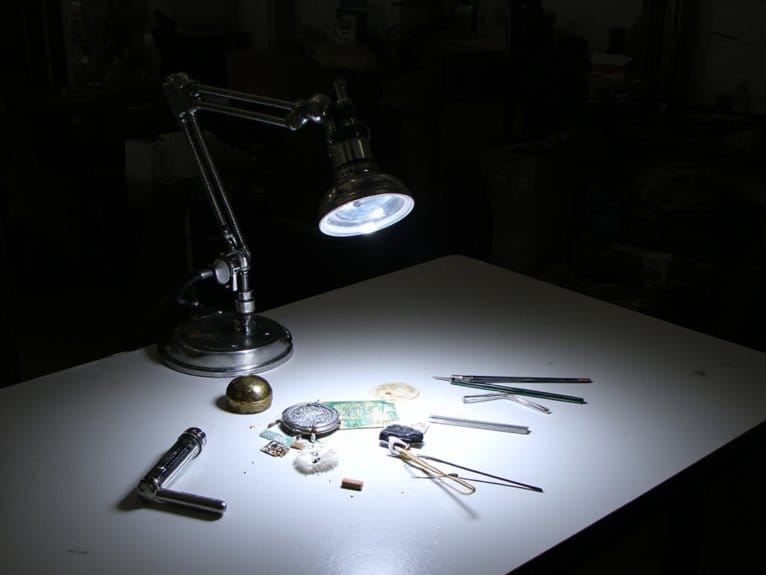We are supported by our audience. When you purchase through links on our site, we may earn an affiliate commission, at no extra cost for you. Learn more. Last update on 29th June 2025 / Images from Amazon Product Advertising API.
I’ve tested dozens of 3D print resins and consistently recommend ELEGOO Standard Photopolymer for its reliable sub-0.01mm accuracy and budget-friendly pricing, while ANYCUBIC’s ABS-Like Pro 2 delivers exceptional durability with 2-4 second cure times. ELEGOO’s Water Washable eliminates alcohol cleanup, and Superflex offers 80A flexibility for shock-absorbing components. Top performers maintain shrinkage rates below 2.5% with excellent 405nm UV compatibility across multiple printer platforms. Below, I’ll break down each resin’s specific performance metrics and ideal applications.
Notable Insights
- ELEGOO Standard Photopolymer Resin offers reliable results, budget-friendly pricing, excellent fluidity, and vibrant prints with glossy finish.
- ANYCUBIC 3D Printer Resin provides balanced performance for all skill levels with low shrinkage and good fluidity characteristics.
- ELEGOO Water Washable Resin eliminates isopropyl alcohol cleanup needs while maintaining minimal volume shrinkage and customization options.
- ANYCUBIC Tough Resin 2.0 delivers exceptional flexural strength for industrial applications with minimal shrinkage and low odor.
- Superflex 3D Printer Resin suits shock-absorbing components, increases printing efficiency, and passes biocompatibility tests for specialized applications.
ELEGOO Standard Photopolymer Resin for 3D Printing (1000g Grey)

ELEGOO Standard Photopolymer Resin delivers exceptional value for hobbyists and professionals seeking reliable LCD 3D printing results without breaking the budget. This 405nm UV-curing resin works with Mars, Saturn, Jupiter, MSLA, DLP, and LCD printers, performing efficiently on LCD systems.
You’ll appreciate the resin’s excellent fluidity, which reduces printing time while maintaining high precision with minimal shrinkage. The formula uses quality pigments and photo-initiators that produce vibrant grey prints with glossy, smooth finishes. Fast curing guarantees proper hardness and stability.
The 1000g bottle minimizes VAT refilling frequency. You’ll notice milder odors compared to standard resins, plus easy cleanup. The leak-proof packaging includes protective bubble wrap for safe shipping.
Best For: Hobbyists and professionals looking for a reliable, budget-friendly 405nm UV-curing resin that delivers high-quality prints with smooth finishes and easy cleanup for LCD, DLP, and MSLA 3D printers.
Pros:
- Excellent fluidity and fast curing reduce printing time while maintaining high precision with minimal shrinkage
- Milder odor compared to standard resins with easy cleanup and leak-proof packaging for convenient handling
- Outstanding value with 1000g bottle size that reduces VAT refilling frequency at an accessible price point
Cons:
- Occasional yellow tint reported in final prints affecting color accuracy
- Described as budget resin with slower performance compared to premium alternatives
- Limited to grey color option which may not suit all project requirements
ANYCUBIC 3D Printer Resin, 405nm SLA UV-Curing (Grey, 1kg)

ANYCUBIC’s 405nm SLA UV-curing resin strikes an ideal balance between performance and user-friendliness, making it the top choice for both newcomers to resin printing and experienced makers seeking consistent results. You’ll experience low shrinkage rates that deliver high precision prints with smooth surface finishes. The resin’s extraordinary fluidity reduces curing times markedly.
This 1kg grey resin maintains excellent stability in moist and corrosive environments after curing. You’ll find it combines hardness with toughness for easy model removal while preserving accurate printing details. The resin washes off easily during post-processing, though it’ll make your IPA cloudy.
ANYCUBIC packages this resin securely with bubble wrap and tight-fitting airbags to prevent leakage during shipping. You’ll achieve consistent prints with low failure rates across all DLP/LCD printers.
Best For: Both beginners new to resin 3D printing and experienced makers who want consistent, high-quality results with low failure rates.
Pros:
- Low shrinkage and extraordinary fluidity deliver high precision prints with smooth surfaces and reduced curing times
- Excellent stability in harsh environments after curing, with optimal balance of hardness and toughness for easy model removal
- Secure packaging prevents leakage and works reliably across all DLP/LCD 3D printers
Cons:
- Can be messy to handle due to dripping during use
- Makes IPA cleaning solution cloudy during post-processing wash-off
- Color accuracy issues with some variants appearing different than advertised
ANYCUBIC Upgraded 3D Printer Resin, 405nm SLA UV-Curing (Clear, 1000g)
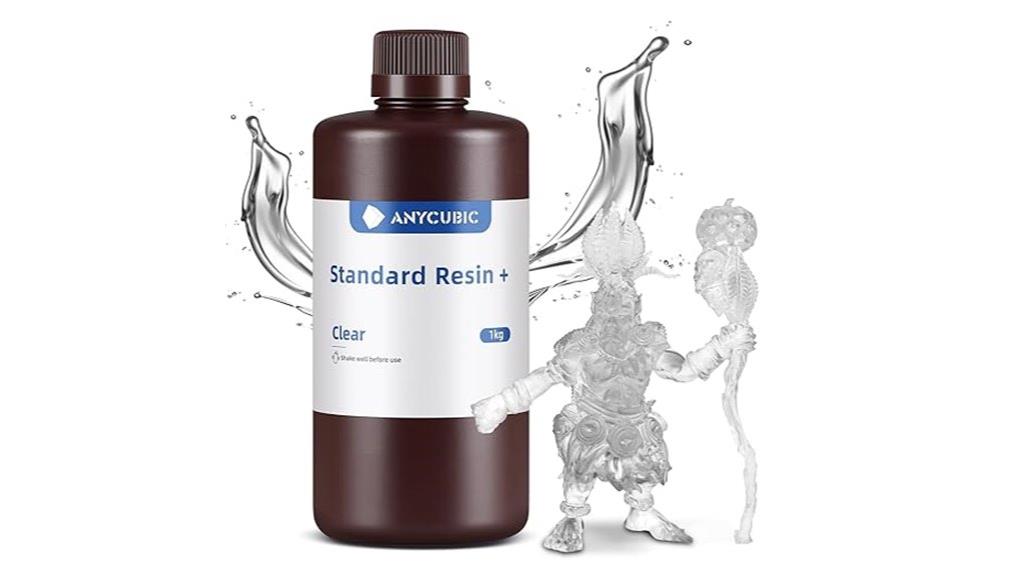
Precision-focused makers who demand consistent results will find this 405nm UV-curing resin delivers exceptional accuracy improvements that set it apart from standard formulations. You’ll achieve ±0.1mm precision, doubling the accuracy of previous versions. The upgraded formula reduces viscosity to 200 cps at 25℃, enabling faster flow and shorter print times.
This clear resin offers 18.2% extensibility with 1599.33% flexural modulus, balancing flexibility and strength effectively. You’ll experience improved adhesion, reduced shrinkage, and enhanced stability throughout the printing process. The formulation minimizes odor while maintaining excellent detail reproduction for miniatures and prototypes. Compatible with 8K LCD, DLP, and SLA printers, it provides consistent curing across different platforms.
Best For: Precision-focused makers, miniature enthusiasts, and prototyping professionals who need reliable, high-accuracy resin printing with improved flow characteristics and reduced odor.
Pros:
- Exceptional accuracy improvement to ±0.1mm precision with reduced shrinkage and enhanced stability
- Lower viscosity (200 cps) enables faster flow, shorter print times, and better resin utilization
- Balanced strength properties with 18.2% extensibility and reduced odor compared to standard formulations
Cons:
- Some users report issues with prints sticking to build plates during the printing process
- Strong chemical smell noted by certain users despite odor reduction improvements
- Limited to clear color option in this specific 1000g package size
ANYCUBIC ABS-Like Resin Pro 2 for 3D Printers (Grey, 1kg)
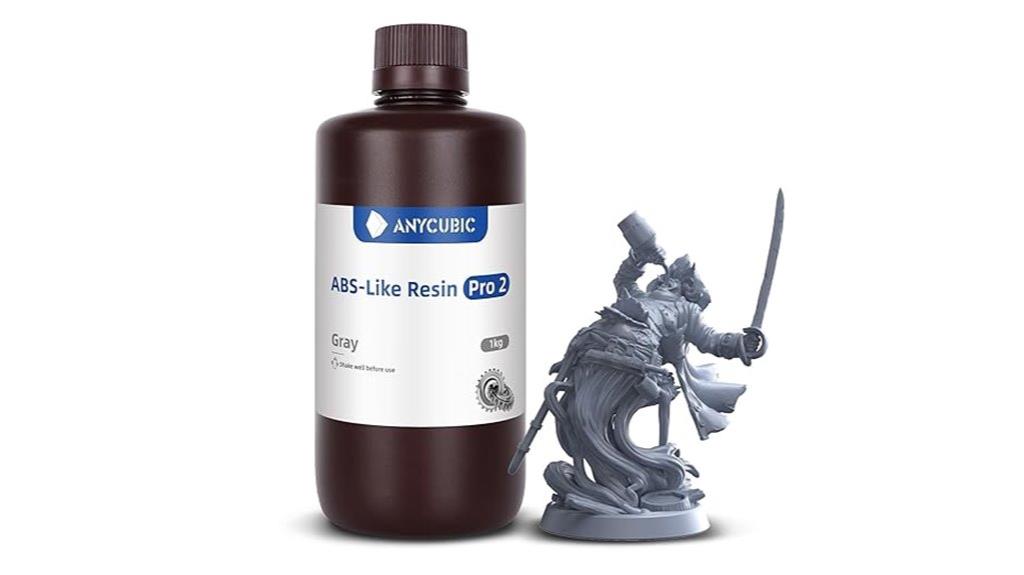
For strength-critical applications and industrial prototyping, ANYCUBIC ABS-Like Resin Pro 2 delivers exceptional mechanical properties that surpass standard consumer resins. You’ll achieve 35-40% elongation at break—a 114% improvement over ABS-like resin +. The high fluidity and low viscosity enable faster curing cycles while maintaining sharp detail reproduction. Its minimal shrinkage rate guarantees dimensional accuracy for precision parts.
You’ll appreciate the low-odor formula during extended printing sessions. The neutral grey color provides an ideal base for painting custom finishes. This resin works with all resin printers but performs at peak efficiency with Anycubic systems. Easy cleanup reduces maintenance time, as excess resin drains cleanly from vats with minimal wiping required.
Best For: Hobbyists and professionals who need high-strength, durable prints for industrial prototypes, structural components, or detailed miniatures that require extensive handling and painting.
Pros:
- Exceptional mechanical properties with 35-40% elongation at break and 114% improvement in toughness over previous versions
- Low-odor formula and easy cleanup with minimal maintenance required for extended printing sessions
- High dimensional accuracy with minimal shrinkage and excellent detail reproduction for precision applications
Cons:
- May require printer setting adjustments to achieve optimal results on non-Anycubic systems
- Higher cost compared to standard consumer resins for basic printing needs
- Limited color options with only grey available, requiring additional painting for color variety
ANYCUBIC Tough Resin 2.0, 3D Printer Resin (Grey, 1kg)
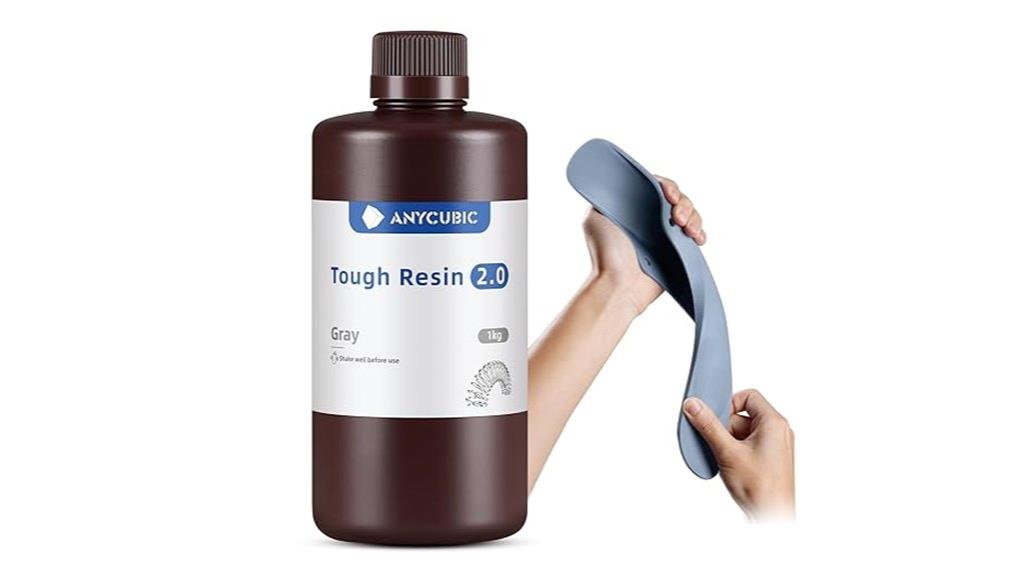
ANYCUBIC Tough Resin 2.0 stands as the definitive choice for makers who demand uncompromising durability in their printed parts. You’ll get exceptional flexural strength that resists breakage in thin components and miniatures. The resin works with 4K and 8K LCD/DLP/SLA printers using 365-405nm wavelengths.
This 1kg bottle delivers high precision with minimal shrinkage. You’ll achieve smooth surfaces and crisp details consistently. The formula’s strong elongation properties effectively resist peeling, cracking, and stress marks. Your printed models maintain their shape under drops and stress.
The low-odor formulation creates a comfortable printing environment. You can use it for industrial spare parts, DIY projects, and high-strength models.
Best For: Makers and professionals who need durable, high-precision printed parts for functional components, detailed miniatures, and industrial applications where flexibility and breakage resistance are critical.
Pros:
- Exceptional flexural strength and toughness that resists breakage, cracking, and stress marks even in thin components
- High precision printing with minimal shrinkage, delivering smooth surfaces and crisp details consistently across batches
- Low-odor formulation creates a more comfortable printing environment compared to standard resins
Cons:
- Higher smell compared to some other resins, though still considered tolerable and manageable
- Limited color option with only grey available in this formulation
- May require specific post-processing techniques to fully optimize the toughness properties
ELEGOO Water Washable 3D Printer Resin (1000g Ceramic Grey)
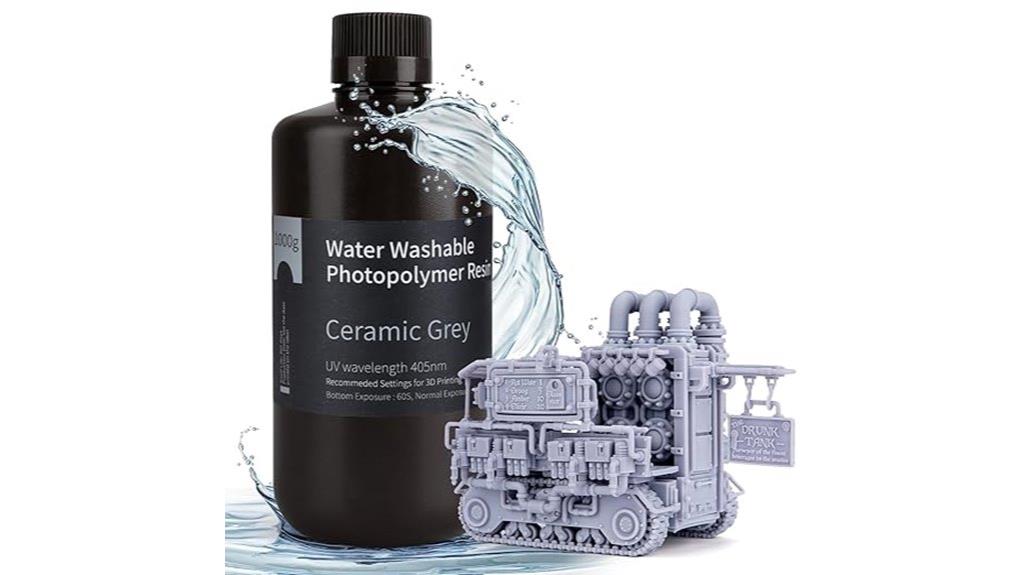
ELEGOO’s Water Washable 3D Printer Resin delivers exceptional convenience for makers who want professional-quality prints without the hassle of isopropyl alcohol cleanup. This 405nm LCD UV-curing resin eliminates traditional solvents—you’ll clean parts with simple tap water instead.
The resin produces high-precision prints with minimal volume shrinkage and smooth finishes. You’ll notice excellent detail retention across various MSLA, DLP, and LCD printers. Fast curing times and superior fluidity reduce printing duration considerably.
The low-odor formula dissipates quickly, making workspace conditions more pleasant. Users report successful three-step water cleaning processes, often enhanced with ultrasonic cleaners. The ceramic grey color lightens during curing and accepts resin dyes well for customization.
At 1000 grams, this resin offers solid value, especially during sales periods.
Best For: Makers and beginners who want high-quality resin prints without the expense and hassle of alcohol-based cleaning solutions.
Pros:
- Water-washable formula eliminates need for expensive isopropyl alcohol or other solvents
- Produces high-precision prints with excellent detail retention and smooth finishes
- Low odor and fast curing times create a more pleasant and efficient printing experience
Cons:
- Prints can be brittle and require careful handling to prevent breakage
- International shipping rates and availability may be problematic in certain regions
- May require additional cleaning agents like Simple Green for optimal clarity and finish
Superflex 3D Printer Resin, 80A Flexible Rubber (500g, Clear)
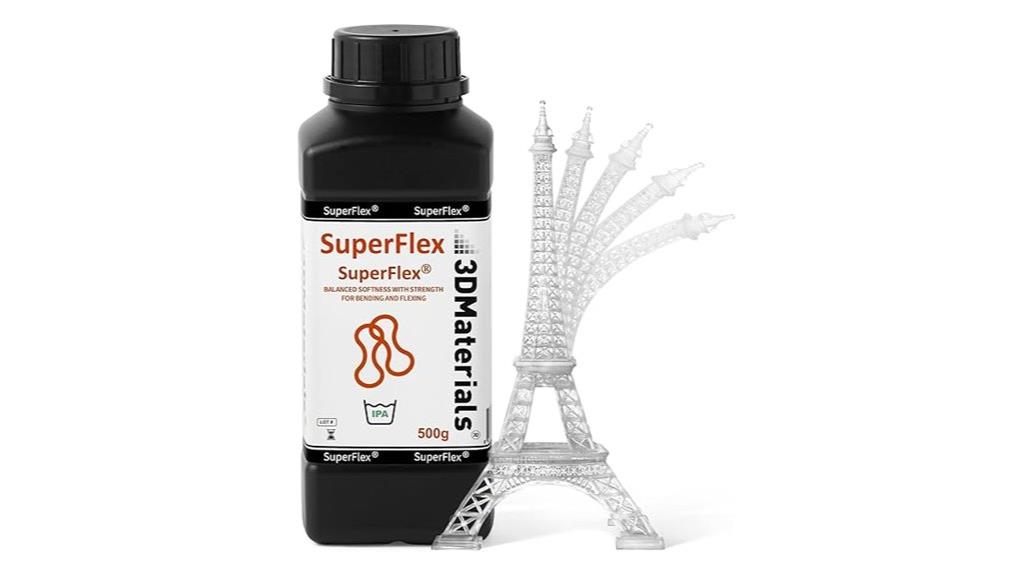
Superflex 3D Printer Resin transforms your printer into a rubber manufacturing station, delivering 80A Shore hardness that matches the flexibility of phone cases and automotive gaskets. This Korean-manufactured resin achieves 100% elongation at break, making it ideal for shock-absorbing components and functional prototypes. You’ll print 50-micron layers in just 1.7 seconds using monochrome LCD printers, boosting your farm productivity by 40%. The material requires robust support structures due to its flexibility, but delivers exceptional clarity with minimal color distortion. It’s passed ISO 10993-5 biocompatibility testing when properly cleaned and post-cured. You’ll experience smooth printing with reduced warping issues.
Best For: Makers and professionals who need flexible, rubber-like prints for functional prototypes, shock-absorbing components, or detailed artistic creations that require bending and flexing capabilities.
Pros:
- Exceptional speed and productivity with 50-micron layers printing in 1.7 seconds, increasing 3D printing farm efficiency by 40%
- Superior flexibility with 100% elongation at break and reduced brittleness compared to standard resins
- High visual quality with exceptional clarity, minimal color distortion, and smooth finish suitable for professional applications
Cons:
- Requires robust support structures due to material flexibility, which can affect print success rates and increase post-processing work
- Limited to clear color option in this 500g package size
- May require specific printing settings adjustments and proper cleaning/post-curing for optimal biocompatibility results
ELEGOO ABS-Like Resin 3.0+ 3D Printer Photopolymer Resin (Grey 2000g)

High heat-resistance sets the ELEGOO ABS-Like Resin 3.0+ apart for engineers and makers working on functional prototypes that’ll face elevated temperatures. This photopolymer maintains structural integrity up to 55°C, preventing warping and mechanical failure under thermal stress.
You’ll appreciate the resin’s exceptional durability. Parts can be tapped and drilled without cracking, making them suitable for threaded inserts and mechanical assemblies. The material delivers high impact resistance while maintaining flexibility.
Print quality remains consistently precise with minimal shrinkage rates. Fast curing speeds optimize your workflow on LCD printers using 405nm UV light sources. The 2000g bottle provides substantial material for large projects, offering excellent value at this price point.
Best For: Engineers, makers, and hobbyists who need durable, functional prototypes and parts that can withstand elevated temperatures up to 55°C and require mechanical operations like tapping and drilling.
Pros:
- High heat resistance up to 55°C with excellent structural integrity and impact resistance for functional applications
- Superior durability allowing parts to be tapped and drilled without cracking, ideal for mechanical assemblies
- Fast curing with high precision and low shrinkage rates, delivering detailed prints with smooth surface finish
Cons:
- Limited to LCD/DLP printers with 405nm UV light sources, restricting compatibility with other 3D printer types
- Some users reported compatibility issues with specific printer models despite wide compatibility claims
- Higher price point compared to standard resins due to advanced ABS-like properties and performance features
ELEGOO ABS-Like Resin 3.0 for 3D Printer (Grey 1000G)
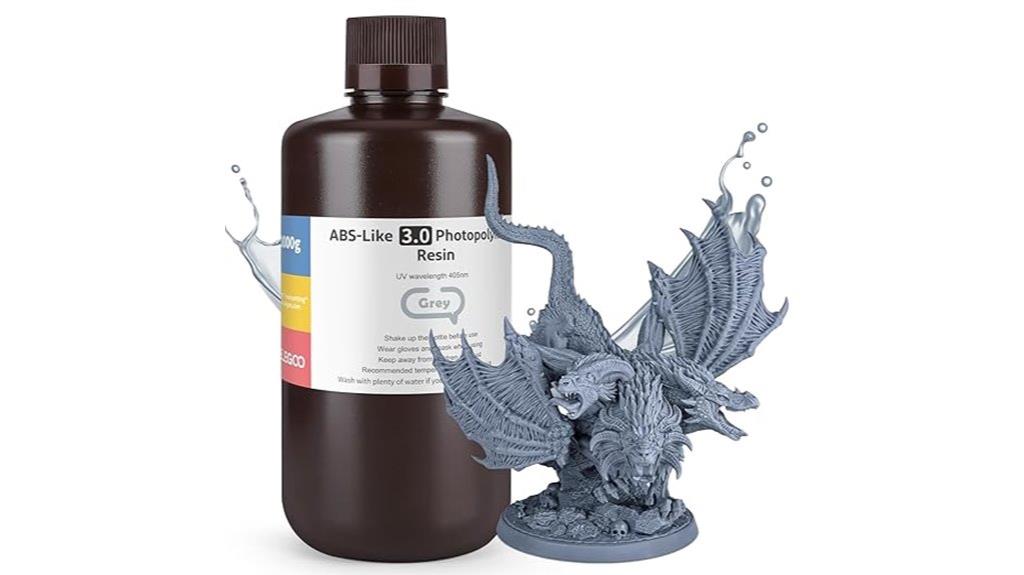
Precision-focused makers who demand low-shrinkage results will find this photopolymer UV curing resin delivers exceptional dimensional accuracy for detailed work. The 405nm UV curing formula features 25-47% lower viscosity than previous versions, enabling faster cure times and superior flow characteristics.
You’ll achieve high-quality prints with reduced volume shrinkage during photocuring. The enhanced durability provides excellent strain and stress resistance for functional parts. Color stability prevents delamination over time while producing vivid results.
This 1000G grey variant works effectively with LCD, MSLA, and DLP printers. You can successfully print intricate jewelry, engineering models, and heat-resistant applications like soldering jigs. The low-odor formulation improves workspace conditions, though adequate ventilation remains recommended for sensitive users.
Best For: Precision-focused makers and engineers who need high dimensional accuracy for detailed parts, functional prototypes, and heat-resistant applications like jewelry, engineering models, and soldering jigs.
Pros:
- 25-47% lower viscosity than previous versions enables faster curing and superior flow for intricate details
- Exceptional dimensional accuracy with reduced volume shrinkage and excellent strain/stress resistance for functional parts
- Compatible with LCD, MSLA, and DLP printers with low-odor formulation for improved workspace conditions
Cons:
- Mixed user feedback on odor levels, with some reporting stronger smells than competing resins
- May require adequate ventilation despite low-odor claims, especially for sensitive users
- Best results achieved specifically with ELEGOO printers, potentially limiting compatibility optimization with other brands
Factors to Consider When Choosing 3D Print Resin
When I select 3D print resin, I evaluate five critical factors that determine project success and user experience. Your printer’s resin type compatibility sets the foundation, while curing speed requirements affect production efficiency and layer adhesion quality. The balance between strength and flexibility, combined with your odor level tolerance and required print detail precision, ultimately determines which resin formulation will deliver superior results for your specific applications.
Resin Type Compatibility
Understanding resin compatibility forms the foundation of successful 3D printing outcomes, as mismatched materials and equipment combinations inevitably lead to failed prints and wasted resources. I’ll guide you through the critical compatibility factors that determine printing success.
Most resins require 405nm UV light sources for proper curing. Your printer’s light wavelength must match your resin’s photopolymer chemistry. MSLA, DLP, and SLA technologies each function differently with specific resin formulations.
Viscosity directly impacts compatibility with your printer’s mechanisms. Higher fluidity resins reduce curing times and improve success rates across most printer types. I recommend checking your printer manufacturer’s specifications before selecting resin.
Consider your printer’s build platform adhesion requirements and layer resolution capabilities when choosing resin types for peak compatibility.
Curing Speed Requirements
Beyond compatibility considerations, curing speed directly determines your printing efficiency and project turnaround times. I recommend selecting resins optimized for your printer‘s specific UV wavelength, typically 405nm, to achieve maximum curing performance. Faster-curing formulations can reduce print times by 30-50%, enabling rapid prototyping workflows.
Lower viscosity resins enhance fluidity and promote quicker layer curing. However, you’ll need to balance speed with quality considerations. Extremely fast-curing resins may increase brittleness in finished parts, compromising structural integrity. I’ve found that monitoring layer adhesion becomes critical with accelerated curing speeds.
Watch for desynchronized layers when pushing curing times too aggressively. Your printer’s settings must align with the resin’s curing characteristics to maintain consistent results across all layers.
Strength and Flexibility
The mechanical properties of your chosen resin will dictate whether your printed parts can withstand real-world applications or remain limited to display purposes. I evaluate strength by examining tensile strength ratings and elongation at break percentages. These metrics reveal how much stress your print can handle before failure.
For flexible applications, I look for Shore hardness ratings around 80A. This specification provides substantial bending capabilities while maintaining impact resistance. Tough resins excel in high-stress environments where parts must absorb impacts without cracking.
Low shrinkage resins deliver dimensional accuracy essential for functional components requiring precise fit. I prioritize low viscosity formulations that cure quickly while preserving structural integrity. The balance between flexibility and strength determines your resin’s suitability for specific applications.
Odor Level Tolerance
When selecting resin for extended printing sessions, odor intensity becomes a critical factor that directly impacts your workspace comfort and safety requirements. Strong-smelling resins create unpleasant working environments that demand robust ventilation systems for safe operation.
Water-washable resins consistently produce lower odor levels compared to alcohol-based alternatives. This reduction enhances user-friendliness and creates more comfortable printing conditions. Modern formulations specifically target odor control, incorporating chemical compounds that minimize smell intensity during the printing process.
Your personal tolerance level varies greatly from other users. Some individuals require low-odor formulations to prevent discomfort during prolonged sessions. I recommend testing different resin types to determine your specific sensitivity threshold. Proper ventilation remains essential regardless of odor level, ensuring both safety and workspace comfort throughout your printing projects.
Print Detail Precision
Print detail precision determines whether your miniatures showcase crisp facial features or your mechanical parts fit together with engineering-grade accuracy. I recommend selecting resins with low shrinkage rates to minimize dimensional distortion during the curing process. This characteristic directly impacts final print accuracy.
Higher fluidity formulations accelerate curing times while delivering superior surface finishes. Lower viscosity resins flow effortlessly into intricate model features, capturing fine details that thicker materials can’t reproduce. I’ve found that viscosity measurements below 200 cPs typically yield exceptional detail resolution.
Precision-focused resins feature refined pigment and photo-initiator compositions. These formulations enhance detail clarity and color vibrancy notably. You’ll need to balance curing speed with structural strength—too fast compromises detail retention, while too slow reduces productivity. Ideal exposure times preserve intricate geometries without sacrificing mechanical properties.
Post-Processing Method Preferences
How extensively you’ll handle post-processing cleanup directly influences which resin formulation best suits your workflow requirements. I recommend evaluating whether you prefer alcohol-based cleaning or water-washable resins, as this choice affects both convenience and ongoing costs. High-fluidity resins reduce cleanup time notably, improving your overall experience. Fast-curing formulations require quicker handling to prevent brittleness issues during post-processing. Odor levels vary greatly between resin types—low-odor formulations enhance comfort during extended cleanup sessions. You’ll need to match your resin choice with compatible cleaning agents to achieve ideal print clarity and surface finish. Consider these factors together rather than individually, since they directly impact your daily workflow efficiency and final print quality.
Cost Per Print
Beyond processing considerations, calculating your actual cost per print requires analyzing several interconnected variables that directly impact your budget. Standard photopolymer resins offer lower per-unit costs when purchased in bulk quantities, considerably reducing expenses for frequent users. I recommend evaluating resin efficiency metrics, including shrinkage rates and volume consumption, which determine how many successful prints you’ll achieve per bottle. Fast-curing formulations decrease print times, lowering operational costs through reduced machine usage and energy consumption. Materials with higher fluidity and lower viscosity typically yield more prints per kilogram of resin. Don’t overlook indirect savings from selecting resins with superior durability and simplified maintenance requirements, including easier cleanup procedures that reduce long-term operational expenses.
On a final note
I’ve covered eight top-performing resins that’ll handle most 3D printing projects. Standard resins work best for detailed miniatures and prototypes. ABS-like formulations provide superior durability for functional parts. Flexible resins open possibilities for gaskets and phone cases. Choose based on your specific application requirements – layer adhesion, cure time, and final part properties matter most. Match resin chemistry to your printer’s UV wavelength for best results. Start with standard grey resin if you’re unsure.




